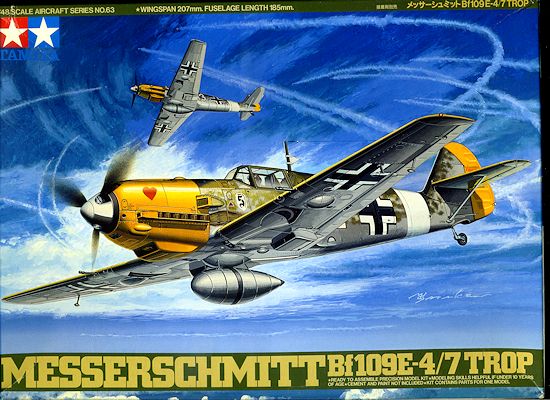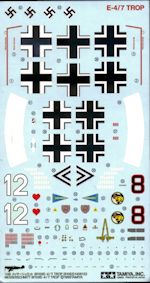
Tamiya 1/48 Bf-109E-4/7trop
|
KIT # |
61063 |
|
PRICE: |
Currently $32.00 SRP |
|
DECALS: |
Three options |
|
REVIEW : |
|
|
NOTES: |

|
HISTORY |
When one thinks about famous fighters of World War 2, one of the first ones that pops into mind is the Messerschmitt Bf-109. First flown in the mid 1930s and thoroughly tested in Spain during 1937/38, it was the most successful German fighter of the war. In addition, it was in action from the first to the last day of the war.
Where the 109 became truly well known was during the Battle of Britain, where it was pitted against the Hurricanes and Spitfires of the RAF. Here the short range of the 109 was to prove a deficit to those 109 pilots whose job it was to protect German bombers. It was also here that the 109E version was truly blooded, having missed out in most of the action during the Spanish Civil War. The range situation was taken care of very late in the Battle of Britain with the introduction of the 109E-7 version. This was plumbed to carry a drop tank, something that would have been a lot more useful earlier in the year. This equipment was later retrofitted to many earlier versions.
|
THE KIT |
 I
was surprised to see that this kit had not yet been added to the preview pages
so figured I'd provide one for those who are unaware of the kit. Tamiya's kit of the Bf-109E was heralded by many to be the best 'Emil' on the
market. The early production Bf-109E-3 kits have a flaw in the nose
section. The angle of the nose from the upper intakes forward is too shallow.
With the kit standing by itself, this is not at all noticed, but when compared
to the other current crop of E's from Hasegawa and Hobbycraft, it is noticeable.
It is to Tamiya's credit that they redid the nose section at a higher angle. It
should also be pointed out that this modification and the one they did on the
Meteor were done by removing material from the mold. Would the correction
have needed the addition of material to the mold, I seriously doubt if it
would have been done.
I
was surprised to see that this kit had not yet been added to the preview pages
so figured I'd provide one for those who are unaware of the kit. Tamiya's kit of the Bf-109E was heralded by many to be the best 'Emil' on the
market. The early production Bf-109E-3 kits have a flaw in the nose
section. The angle of the nose from the upper intakes forward is too shallow.
With the kit standing by itself, this is not at all noticed, but when compared
to the other current crop of E's from Hasegawa and Hobbycraft, it is noticeable.
It is to Tamiya's credit that they redid the nose section at a higher angle. It
should also be pointed out that this modification and the one they did on the
Meteor were done by removing material from the mold. Would the correction
have needed the addition of material to the mold, I seriously doubt if it
would have been done.
Anyway, the kit is just what one would expect from Tamiya in that the detailing is superb and the engineering top-notch. Detailing seems a bit heavy compared to the Hasegawa and Hobbycraft kits, but I don't think it detracts at all. The parts are all flash free and devoid of any ejector pin marks where they will show. On the down side, there are a number of sink marks, most notably on the trailing edge of the upper wing and on the fuselage side opposite the cockpit detail. The cockpit is quite complete and there is nice detail on the inside of the fuselage.
You get positionable flaps, slats, and rudder, as well as the ability to
display the canopy open. This kit provides the later, more heavily framed
canopy and windscreen used by these later versions. This was retrofitted to some
of the E-1/3 versions. There are also three spinners, one open
and two bullet-shaped ones, one with a greater point than the other. Also
included is a drop tank and mount, which was applicable to the E-7 and many E-4s
so check your references if using aftermarket decals. Another
nice touch is that the outer wheel centers are separate from the wheels, making
it that much easier to paint. It is interesting to compare the Tamiya and
Hasegawa kits. Both produce
 fine kits and each has a slightly different way of
engineering its kits to achieve this result.
fine kits and each has a slightly different way of
engineering its kits to achieve this result.
The decal sheet includes markings for three aircraft. first is the yellow nose box art aircraft from 7./JG 26 in RLM 74/75/76. The aircraft has a white fuselage band (supplied as a decal). Next is the tropical version in RLM 78/79/80 with a white fuselage band and a red/white spinner. This desert scheme plane has been heavily photographed during the war and I'm sure you have seen images of it flying low over the scrub. The last one is Hemut Wick's plane with JG2. It is in RLM 7/02/65 with a yellow nose and lower rudder.
Instruction sheet is typical of Tamiya in that it is very complete and offers all paint references in Tamiya paint colors, which means that some pretty common shades will need to be mixed. There is also an additional sheet that just includes the basic paint scheme, a feature that is much appreciated. Decals are well done and should provide no issues.
|
THE KIT |
Despite this kit being relatively old, first coming out in 1998, it is still one of the major choices of people modeling this particular aircraft. There is a ton of aftermarket out there for those who wish to pursue that venue and it does make into a very nice model.
Review copy courtesy of me and the MM Sales page. Thanks Joe!
If you would like your product reviewed fairly and fairly quickly, please contact the editor or see other details in the Note to Contributors.